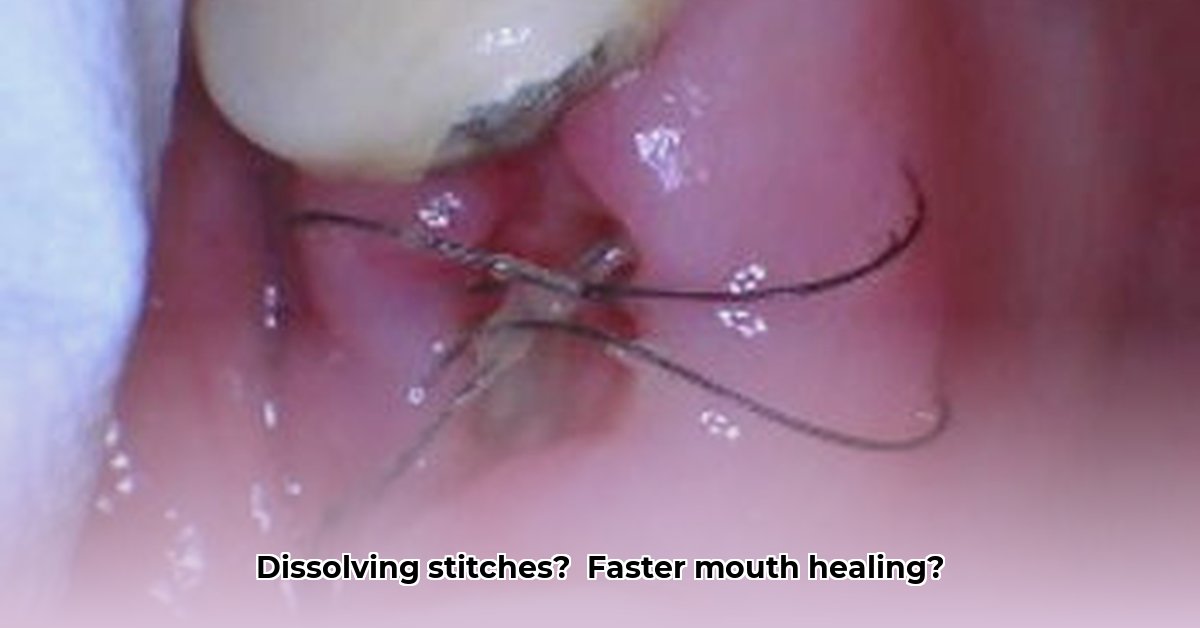“`markdown
Faster Healing: Dissolvable Stitches in Mouth?
Having oral surgery, like getting a tooth pulled, can be a bit scary. But what if healing could be easier and less messy? This guide explains dissolvable stitches – those handy little things that disappear on their own. We’ll cover why they’re used, how to take care of them, and what to expect after your surgery. We’ll keep it simple and straightforward, so you’ll feel confident and prepared for a smooth recovery. We’ll even share some tips from experienced dentists and other patients to help you heal faster. For more detailed info, check out this helpful article on dissolvable stitches.
Dissolvable Mouth Stitches: A Smoother Path to Recovery and explore options like Vicryl?
Getting your mouth stitched up after surgery? It’s a common experience, but the idea of another appointment just to get those stitches removed isn’t appealing. That’s where dissolvable stitches come in – a potentially quicker and more convenient way to heal. But are they the right choice for you, considering healing duration and potential complications? Let’s dive in and weigh the pros and cons regarding infection prevention with enhanced recovery.
What Are Dissolvable Mouth Stitches for optimal wound closure?
Imagine tiny, self-destructing threads holding your wound together. That’s essentially what dissolvable stitches, also called absorbable sutures, are. These clever little things are made from special materials like Polydioxanone (PDS) or Polyglycolic acid (PGA). Your body gradually absorbs these materials, eliminating the need for a follow-up visit to have them removed. Think of them as temporary scaffolding for your healing tissue, offering a comfortable experience by reducing additional appointments.
How Long Do They Take to Dissolve for enhanced patient comfort?
The timeframe for dissolving varies depending on the type of stitch and your body’s healing process. Some might vanish within a week; others could take up to a couple of weeks. Your oral surgeon will select the right type based on your specific surgery and healing needs. It’s a personalized choice, not a one-size-fits-all solution, influenced by individual factors such as metabolic rate.
The Upsides of Dissolvable Stitches and reduced clinic visits
Several benefits make dissolvable stitches an attractive option:
-
No Second Trip to the Dentist: This is a major plus for many people. No more scheduling hassles or extra time off work just for stitch removal, improving the overall patient journey.
-
Lower Infection Risk: Because there’s no removal procedure, there’s also a reduced chance of bacteria getting introduced into the healing wound, promoting faster recovery using biocompatible materials.
-
Potentially Faster Healing: Some studies suggest that dissolvable stitches may lead to slightly faster healing, but everyone heals at their own pace. The effect is likely modest, and more research is ongoing in this area, depending on individual healing capacities.
Potential Downsides: What Could Go Wrong with absorbable sutures?
While generally safe and effective, it’s important to acknowledge that a few less common issues might arise:
-
Slower-Than-Expected Dissolution: In rare cases, the stitches may take longer to dissolve than anticipated, influenced by factors like saliva pH levels.
-
Premature Loosening: Occasionally, a stitch might come loose before it’s fully done its job. This is unusual, but your dentist will know how to manage it, ensuring proper tissue adhesion.
-
Mild Irritation: Some minor swelling, redness, or discomfort around the stitches is possible. This usually resolves quickly, often managed with over-the-counter analgesics.
It’s important to remember these potential drawbacks are infrequent exceptions, not the rule. Your dentist will discuss the likelihood of any complications with you and will monitor you closely.
What to Expect After Your Surgery involving dissolvable sutures
Your surgeon will provide detailed instructions tailored to your procedure. However, here are some general post-surgery care guidelines:
- Gentle Cleaning: Brush and floss carefully around the surgical area, avoiding direct contact with the stitches as much as possible. Your dentist will give specific guidance.
- Soft Foods: Stick to a soft food diet initially to reduce strain on the healing wound. Think mashed potatoes, yogurt, and well-cooked vegetables, enhancing patient comfort significantly.
- Pain Management: Follow your dentist’s recommendations for pain medication. Don’t hesitate to ask for adjustments if needed, optimizing pain control for a better patient experience.
- Monitoring for Problems: Keep an eye out for any signs of infection, such as increased pain, swelling, redness, or pus. Contact your dentist immediately if you notice any of these.
Dissolvable vs. Traditional Stitches: Which is Right for You, exploring suture strength comparison?
The choice between dissolvable and traditional (non-dissolvable) stitches depends on several factors. Your surgeon will consider the type of surgery, the location of the wound, your individual health, and even your personal preferences. They will help you decide the best option, taking all this into account. It’s always best to have an open conversation with your dental professional. They can assess your specific circumstances and recommend the most appropriate type of sutures for your situation. Did you know that some dissolvable sutures may be slightly more expensive, but are ultimately more affordable for the patient?
A Quick Comparison: Dissolvable vs. Traditional Stitches considering material composition
| Feature | Dissolvable Stitches | Traditional Stitches |
|---|---|---|
| Removal Method | Dissolves on its own | Requires professional removal |
| Infection Risk | Potentially lower due to no removal procedure | Potentially higher due to the removal procedure |
| Convenience | Significantly higher | Lower; another appointment is necessary |
| Initial Cost | May be slightly higher due to the materials used | Might be slightly lower initially |
| Overall Cost | Potentially lower, as no removal appointment is needed | Potentially higher because of the additional appointment |
Remember, this information is for educational purposes only. It’s not a substitute for professional medical advice. Always consult with your dentist or oral surgeon before making any decisions about your dental care. They’re the experts who can give you the tailored advice you need for your unique situation. The field of dental sutures is constantly evolving, with ongoing research into new materials and techniques, so be sure to ask your dentist about the latest advancements.
How Long Do Vicryl Stitches Dissolve After Oral Surgery: influencing factors and precautions?
Key Takeaways:
- Dissolvable stitches, like Vicryl, offer a convenient alternative to traditional sutures, enhancing overall patient satisfaction.
- How long do Vicryl stitches dissolve after oral surgery? The answer isn’t a single number. Dissolution time depends on several factors, including individual patient physiology.
- Proper oral hygiene is crucial for faster healing and reduced infection risk, contributing to a smoother recovery process.
- Complete resorption (where the stitches are fully gone) might take longer than visible dissolution, requiring patience and adherence to post-operative instructions.
Understanding Dissolvable Sutures and their biocompatibility
Oral surgery often involves stitches. But did you know some stitches dissolve on their own? These magic stitches, called absorbable sutures, are made from materials that your body gradually breaks down and reabsorbs. Vicryl, a common type, is made of polyglactin 910. It’s popular because it’s strong enough to hold tissues together during healing but gentle enough to dissolve without needing removal. What factors actually affect the dissolution rate of vicryl sutures?
So, How Long Do They Take to Dissolve for improved patient outcomes?
This is where things get a little less straightforward. While many sources state that Vicryl stitches typically dissolve within 7 to 14 days, it’s vital to remember that this is a general guideline. Several factors influence the precise timeframe:
- Type of suture material: Vicryl is one type but there are others, each with its own absorption rate, influencing the healing process. Different suture materials like Polydioxanone (PDS), Polyglycolic acid (PGA), and chromic gut have varied dissolution rates. Vicryl Rapide, for instance, dissolves much faster than standard Vicryl.
- Location of the stitches: Dissolution varies depending on the blood supply and tissue movement in different areas of your mouth, like the tongue or gums. Areas with higher blood flow tend to dissolve sutures faster. Stitches in the gums often dissolve quicker than those on the palate.
- Individual healing: Your body’s natural healing process plays a role. Factors such as age, genetics, underlying health conditions, and lifestyle choices (like smoking) can influence the speed of absorption, influenced by the immune system. A patient with diabetes, for example, might experience slower healing and suture dissolution.
- Surgical technique: The way your surgeon places and knots the stitches also influences their lifespan, potentially causing discomfort. Tighter knots can sometimes impede dissolution, while the suture’s placement in areas of high tension might lead to earlier breakage. Careful surgical technique minimizes these issues.
- Saliva Enzymes: Saliva contains enzymes that can contribute to the breakdown of suture material. The composition and pH of saliva can vary between individuals, impacting the dissolution rate.
Think of it like this: imagine leaving sugar cubes in water. Some might dissolve quickly, especially if stirred. Others might take
- Gluten Free Meal Prep Ideas for Delicious, Hassle-Free Eating - November 28, 2025
- Gluten Free Meal Prep for Stress-Free and Healthy Eating - November 27, 2025
- Quick And Easy Chicken Thigh Meal Prep For Weight Loss - November 26, 2025










